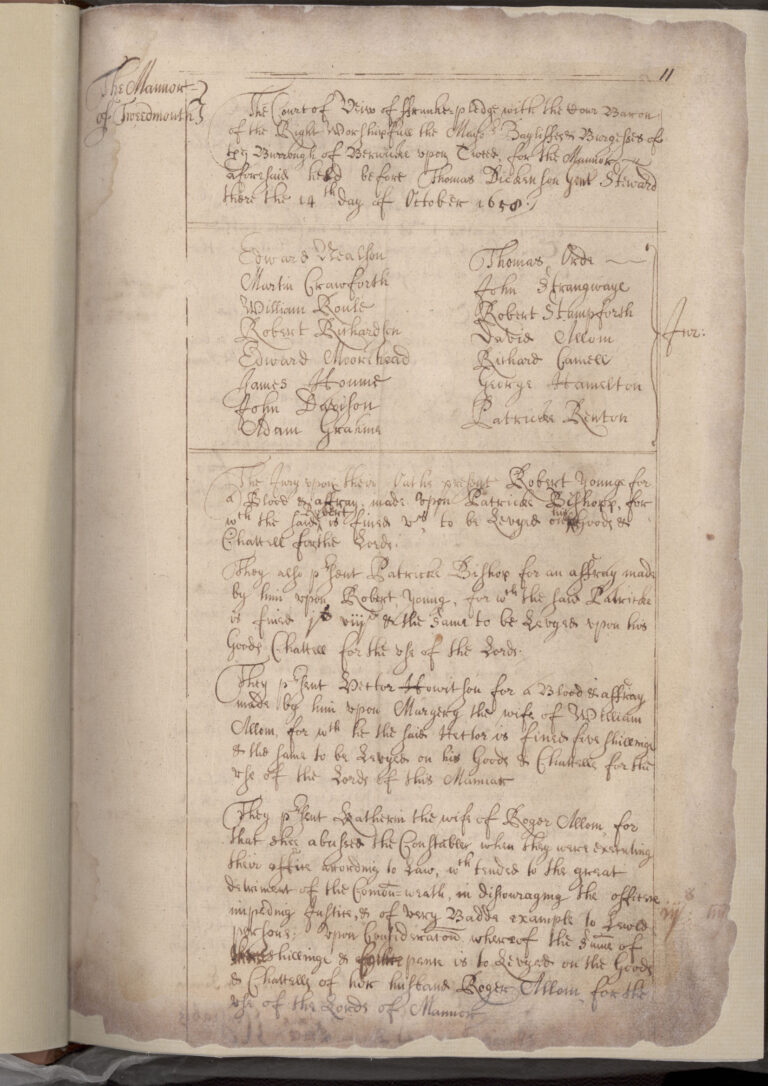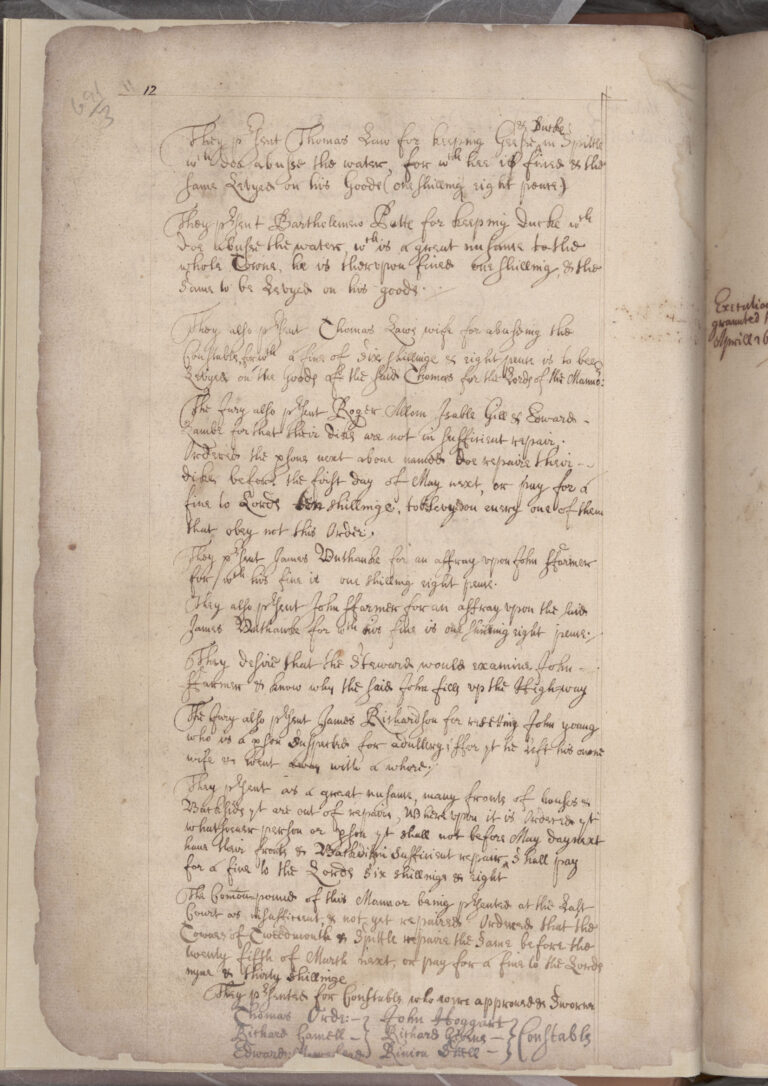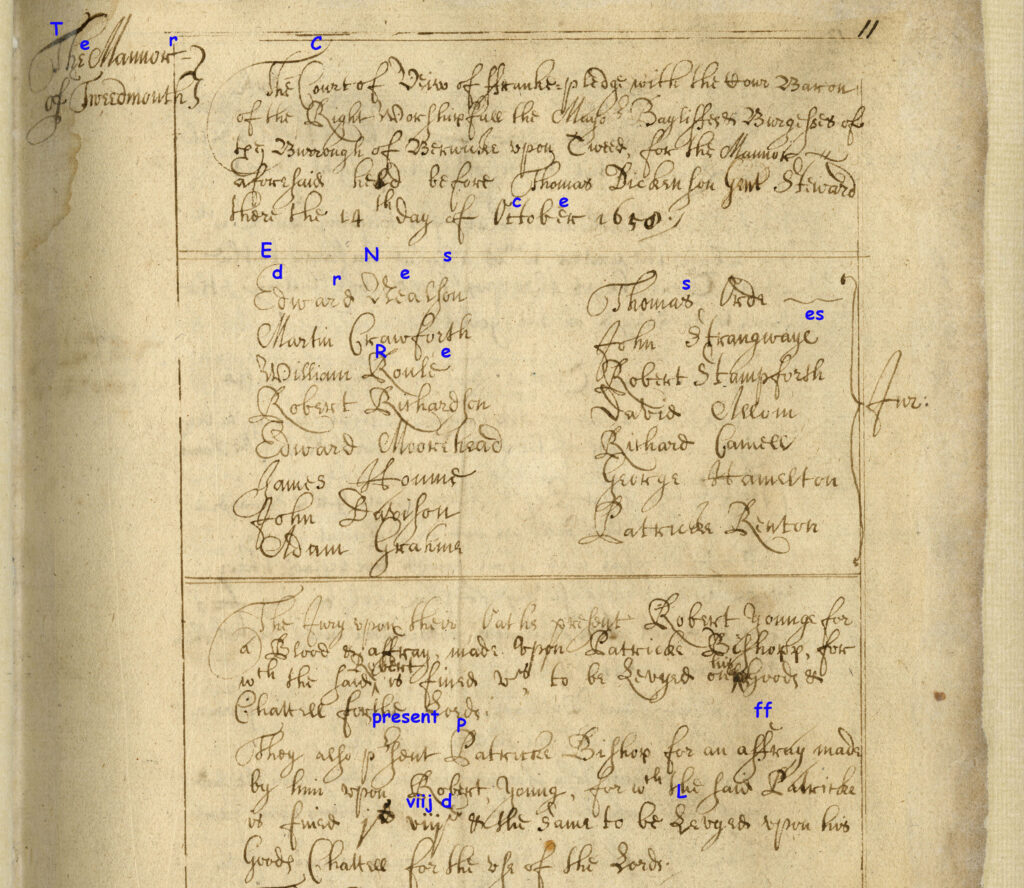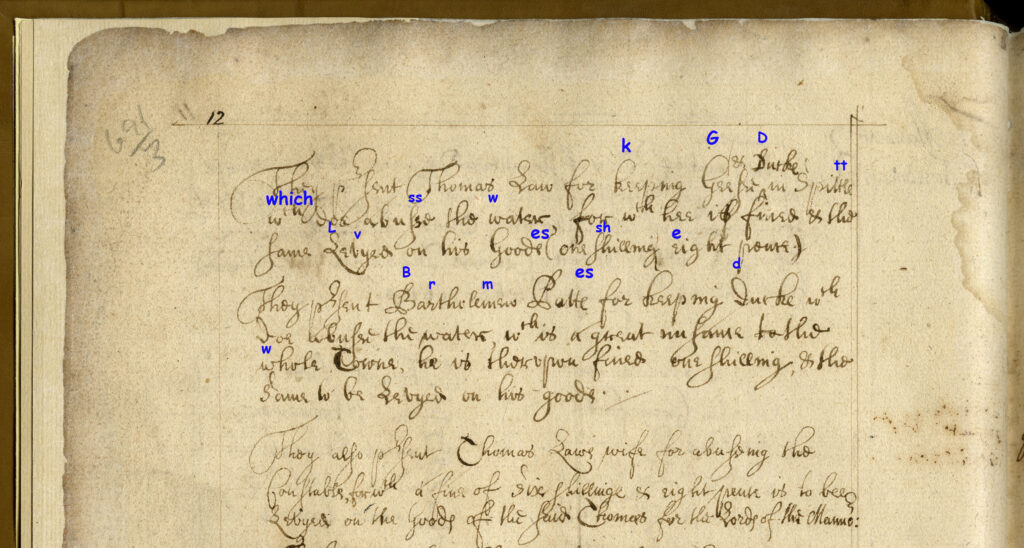Tweedmouth Manor Court Book, 1658-1685
Reference: BA/Q/1/1/p11&12
Suggested age groups: KS2, KS3. KS4, Lifelong Learners
Subject areas: History, Literacy
CONTEXT
The Manor of Tweedmouth and Spittal was purchased in 1657 by Berwick Corporation from the Earl of Suffolk for £570 . Tenants were brought before the Manor Court for minor crimes and fined. Thomas Law was brought before the Court on 14 October 1658 and fined for keeping ducks and geese in Spittal which contaminated the water supply.
Palaeography – The study of old handwriting.
Transcript – A direct copy of the original document. The aim of palaeography is to produce a transcript of the document.
Translation – An interpretation of the original document, for example converted into modern English.
Italics – Italics is a style of handwriting which came about during the Italian Renaissance in the 14th and 15th century. It is traditionally semi-cursive and slightly sloped.
Secretary hand – This was the dominant form of handwriting used by writers of the English language from the late-15th to mid-17th century. It is so named as most of the writing at this time was done by secretaries, clerks, or scribes.
Hints for transcribing documents and how you should set our your transcript.
- Do not have any preconceptions of what a word might be. To start with, each letter should be read individually to help you recognise the letter forms.
- Remember that just as today, everyone had their own individual style of handwriting – no two people write the same way. This means that although alphabets have been published for different styles of handwriting (e.g. secretary hand), they can only act as a guide because every writer develops their own flourishes and variations on letter forms.
- For this reason, use the document you are transcribing as the definitive tool to establish letter forms. This can be done by finding an unrecognised letter form in a word which has already been transcribed. Comparison is the key.
- Spelling in the past was phonetical and not standardised. Therefore, the same word can be spelt in many different ways, even within the one document, even as late as the 19th This can lead to confusion and false assumptions, particularly in relation to family history and the spelling of surnames. If in doubt, try and say the word, preferably with the accent of the writer. This might sound odd but it does work!
- Copy down the spelling as it appears in the original document and if the writer uses capital letters, these should also be retained. These features are all part of the makeup of the original documents and the aim of palaeography is to produce a transcript and not a translation of the original.
- If you are having difficulty reading and transcribing a particular word, there are two ways of tackling it. Firstly, try and divide down the word into its individual letter forms and transcribe them individually – it sometimes helps if you block out all the other letters so that you can only see one letter at a time. Alternatively, if this does not work, leave a space for the word and continue the transcription. Come back to it at the end to see if you can then decipher it having read and hopefully understood the rest of the document. If neither of these two methods work, do not look at the document for a couple of hours and then go back to it with a clear mind and without any preconceptions of what it should say. This often works!
- When producing a transcription of a document, use double spacing when typing it up on a computer. If you are writing it out by hand first, use a pencil and write on alternative lines – this means you have room to make any alterations, can easily rub things out and still make sense of what you have written. The double spacing makes it easier to read the transcript.
- Check over your work once you have finished to ensure that you have kept the original spelling. This is particularly important if you have typed it up on a computer – some programmes have a habit of automatically changing the spelling without you realising it! You may wish to turn autocorrect off on your computer when you are transcribing documents.
When transcribing a document, the following basic conventions should be used. Our aim is to transcribe it and not translate it into modern English:
- Contractions should be extended as far as possible and letters which do not appear in the document should be written in square brackets. The exception to this is the monetary abbreviation li, s, and d used for “£ s d”. Although in original documents contractions are often raised (superscript), they should all be lowered to the same level as the other letters. In a transcription, the use of square brackets around letters denotes that these are the ones which do not appear in the original text.
- The Anglo Saxon thorn should be written as th which are the letters it represents and not as “y” and so “ye” should be transcribed as “the”. And “yt” should be transcribed as “th[a]t.
- Capital letters should be retained in the transcript even if they seem unnecessary to the modern reader. They are part of the character of the document.
- Various conventions are used in relation to ampersand (&) which is used to represent “and” and “et” (the original Latin word for “and”). For our purposes, we shall not expand this contraction but will leave it as “&”. However, if the ampersand appears in the text with another letter (for example, “&c“), it should be expanded to “etc” to make it more understandable to the reader.
- Punctuation is often sadly lacking in documents written in the past which can make it difficult to follow the sense of what is being written. However, as this is the way that a document has been written, modern punctuation should not be added.
- Keep the original line format of the document – i.e., do not make it one continuous narrative but start a new line each time this happens in the original document.
- You may find it helpful to number all the lines when you are working on your transcript – to make sure that you don’t leave anything out. However, these should be removed in your final copy.
- Please make sure that you leave yourself time at the end to check through your work and to make sure that the computer has not modernised the spelling on you – autocorrect is a nightmare for a transcriber.
- You can use footnotes to explain your interpretation of a letter or if words have been crossed out etc. This will make more sense with practice.
11
The Mannor – The Court of View of Franke=pledge1 with the Cour Baron of Tweedmouth of the Right Worshipfull the Mayor Bayliffes & Burgesses of
the Burrough of Berwicke upon Tweed, for the Mannor
aforesaid held before Thomas Dickenson Gent[leman] Steward
there the 14th day of October 1658.
Edward Nealson Thomas Orde
Martin Crawforth John Strangway[es]
William Roule Robert Stampforth
Robert Richardson David Allom Jur[ors]
Edward Moorehead Richard Camell
James Houme George Hamelton
John Davison Patricke Renton
Adam Grahme
The Jury upon their Oaths present Robert Younge for
a Blood & affray, made upon Patricke Bishopp, for
Robert his
w[hi]ch the said ^ is fined v s, to be Levyed on ^ Goods &
Chattell for the Lords;
They also p[re]sent Patricke Bishop for an affray made
by him upon Robert Young, for w[hi]ch the said Patricke
is fined j s v iiid & the same to be Levyed upon his
Goods, Chattell for the use of the Lords.
12
& Duck[es]
They p[re]sent Thomas Law for keeping Geese ^ in Spittle
w[hi]ch doe abusse the water, for whi[ch] hee is fined & the
same Levyed on his Goods (one Shilling eight pence.)
They p[re]sent Bartholemew Patt[es] for keeping duck[es] w[hi]ch
doe abusse the water w[hi]ch is a great nusance to the
whole Towne, he is therupon fined one shilling, & the
Same to be Levyed on his goods.
They also p[re]sent Thomas Laws wife for abuseing the
Constable, for w[hi]ch a fine of six shilling[es] & eight pence is to bee
Levyed on the Goods of the said Thomas for the Lords of the Manno[ur]:
1 ‘ff’ when used as a capital has been transcribed as ‘F’ throughout.
ACTIVITIES
ACTIVITY 1
Background
The Manor of Tweedmouth and Spittal was purchased in 1657 by Berwick Corporation from the Earl of Suffolk for £570 . Tenants were brought before the Manor Court for minor crimes and fined. Thomas Law was brought before the Court on 14 October 1658 and fined for keeping ducks and geese in Spittal which contaminated the water supply.
SEE
See: What is palaeography?
See: What is a transcript?
See: What is a translation?
See: What is italic handwriting?
See: What is secretary hand?
See: Is there anything on this document that gives us a clue what it is about?
See: How many styles of handwriting can you see in this document?
THINK
Think: Why were documents in the past written by hand?
Think: Why is it important for historians and archivists to learn palaeography skills?
Think: What is the difference between a transcript and a translation?
Think: Why is a transcript more useful than a translation to understand an old document?
Think: Why might it be useful to be able to read and understand an old document?
Think: What is a primary source?
Think: What is a secondary source?
DO
Do: Look at this document without context for 10 seconds. What do you notice first? Feed back what you have noticed.
Do: Look at this document without context for 30 seconds. Try to pick out any letters that look familiar to you. Feed back what you have noticed.
Do: On a copy of the document make note of the letters that you were able to identify.
Do: Look at this document without context for one minutes. Try to decipher any words or phrases that stand out to you. Feed back what you have noticed.
Do: On a copy of the document make note of the words that you were able to identify.
Do: Write out the alphabet. For each letter you were able to identify in this document write a copy of the letter in the style of this handwriting next to the corresponding letter in your alphabet.
Do: Go through the document and try to annotate each time your identified letters and words appear. Can you start building new words and sentences?
Do: On a blank sheet of paper, write down as sentences the letters and words you have worked out. Leave a gap where you have been unable to work out a letter or word.
Do: Read the text aloud, can you work out what any of the missing words or letters might be? It might be helpful to try reading the document in the writer’s accent.
Do: Compare your annotated document to the example copy provided. Are there any that you missed that you can now fill in?
Do: Write a short paragraph summarising what you have found out and inferred about this document so far. Compare this to the context. How accurate was your understanding of the document?
Do: Try to write a full transcription of this document.
Do: Look at this document and other examples of old handwriting from the National Archives.
Do: Have a go at trying to recreate this style of handwriting.
Do: Have a go at making an alphabet or writing your name using old-fashioned handwriting. What other types of documents can you make in this style?
Do: Find other examples of old handwriting on the Northumberland Archives LEARN website. Have a go at trying to read, transcribe or replicate them.
Resources
https://northumberlandarchives.com/tag/palaeography/
https://www.nationalarchives.gov.uk/palaeography/default.htm
https://nyarc.org/blog/can-you-read-me-now-a-brief-history-of-italic-script
https://beinecke.library.yale.edu/article/quarantine-reading-learn-read-secretary-hand
https://libguides.furman.edu/special-collections/for-students/primary-secondary-sources
OTHER ONLINE RESOURCES
Northumberland Archives page on learning to read old handwriting: https://northumberlandarchives.com/tag/palaeography/
National Archives page on palaeography: https://www.nationalarchives.gov.uk/palaeography/default.htm
New York Art Resources Consortium page on the history of italic handwriting: https://nyarc.org/blog/can-you-read-me-now-a-brief-history-of-italic-script
Beinecke Rare Book & Manuscript Library guide to reading secretary hand: https://beinecke.library.yale.edu/article/quarantine-reading-learn-read-secretary-hand





